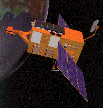The Rossi X-ray Timing Explorer

The Rossi X-ray Timing Explorer, RXTE, was launched on December 30, 1995. RXTE is designed to facilitate the study of time variability in the emission of X-ray sources with moderate spectral resolution. Time scales from microseconds to months are covered in a broad spectral range from 2 to 250 keV. It is designed for a required lifetime of two years, with a goal of five years.
Mission Characteristics
- Proportional Counter Array (PCA)
2-60 keV energy range, 6500 sq cm, time resolution 1 microsec - High Energy X-ray Timing Experiment (HEXTE)
15-250 keV energy range, 2 X 800 sq cm - All-Sky Monitor (ASM)
2-10 keV energy range, 30 mCrab sensitivity
- Discovery of kilohertz QPO's
- Discovery of spin periods in LMXRB
- Detection of X-ray afterglows from Gamma Ray Bursts
- Extensive observations of the soft state transition of Cyg X-1
- Observations of the Bursting Pulsar over a broad range of luminosities, providing stringent test of accretion theories.
![]() Archive : Catalogs, Spectra, Lightcurves, and Raw data
Archive : Catalogs, Spectra, Lightcurves, and Raw data
| RXTE Guest Observer Facility [Researchers] |
| RXTE Learning Center [Public Interest/Education] |
If you have a question about RXTE, please send email to one of our help desks.

